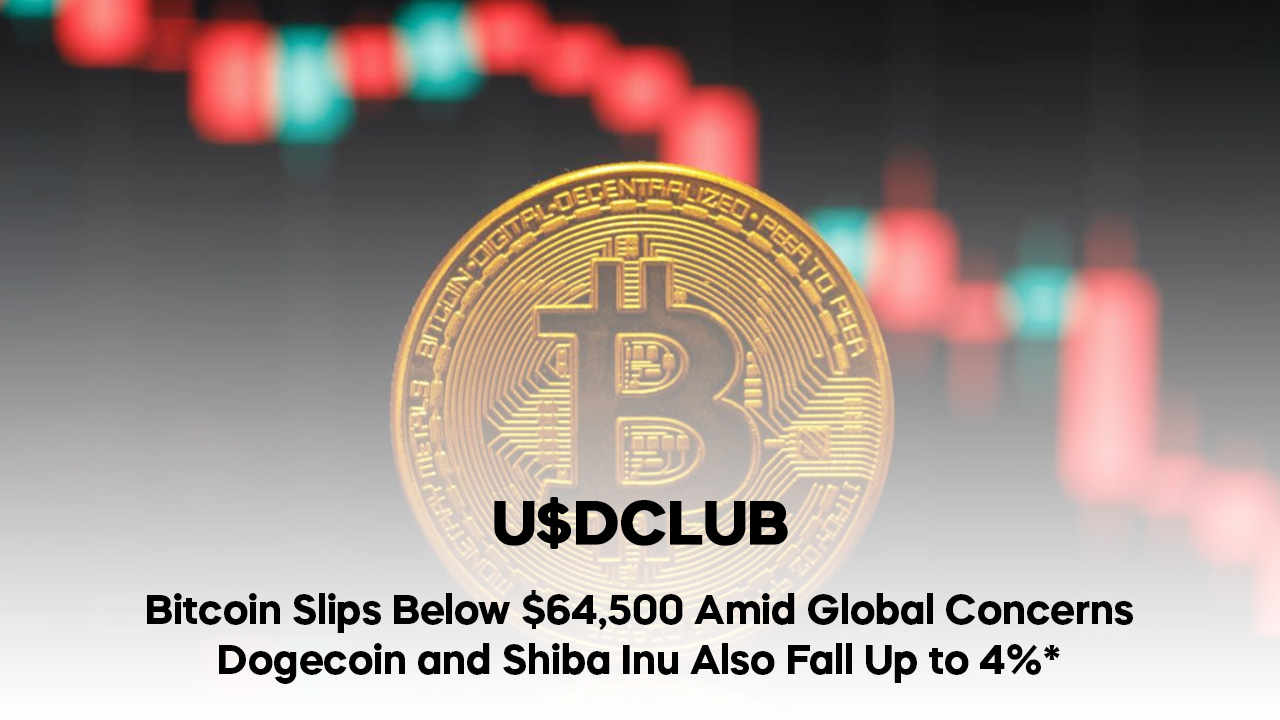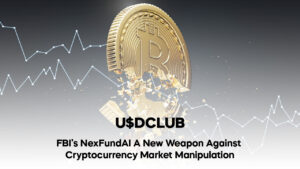The cryptocurrency market has once again demonstrated its notorious volatility, with Bitcoin, the world’s leading cryptocurrency, slipping below $64,500 amid growing global economic concerns. Other major cryptocurrencies, including popular meme coins like Dogecoin and Shiba Inu, also experienced notable declines, with losses of up to 4%. For cryptocurrency investors and traders, the market’s erratic movements have raised questions about the future trajectory of digital assets and the factors influencing the current downturn.
In this blog, we’ll explore the reasons behind the recent drop in Bitcoin, Dogecoin, and Shiba Inu prices, the broader economic concerns that are driving market uncertainty, and how investors can navigate these volatile times. For more updates on the latest developments in the cryptocurrency and stock markets, stay tuned to [USDCLUB.us](https://usdclub.us), where we bring you timely news and analysis from the world of finance.
-
Bitcoin’s Price Slips Below $64,500: What’s Behind the Decline?
Bitcoin’s fall below the $64,500 mark has sent shockwaves through the crypto community, given its reputation as the flagship digital currency and a barometer for the overall health of the cryptocurrency market. While the decline may appear sudden, several underlying factors have contributed to this downward trend.
a) Global Economic Concerns
The global economic landscape is currently marked by a series of challenges, from geopolitical tensions to concerns about inflation and economic slowdown in major economies. These issues have had a ripple effect on financial markets, including the cryptocurrency market. As governments around the world struggle to contain inflation, central banks, including the U.S. Federal Reserve, are taking measures such as raising interest rates to control economic activity. Higher interest rates make traditional assets like bonds and savings accounts more attractive, leading investors to shift their funds away from riskier assets like cryptocurrencies.
b) Uncertainty Over Regulatory Crackdowns
Another significant factor weighing on Bitcoin and other cryptocurrencies is the increasing regulatory scrutiny in several key markets. Governments and financial regulators in countries such as the United States, China, and India are cracking down on cryptocurrency trading, mining, and transactions. In particular, concerns around the use of digital assets for illicit activities like money laundering, as well as their potential to destabilize financial systems, have led to growing calls for stricter oversight. As a result, investor sentiment has been negatively affected, contributing to the recent sell-off.
c) Profit-Taking by Investors
After Bitcoin’s impressive run over the past year, many long-term investors are now opting to take profits, especially as market uncertainty grows. Bitcoin’s price reached an all-time high of nearly $69,000 earlier this year, and for some investors, this presented an opportunity to cash out before further corrections. The resulting selling pressure has contributed to Bitcoin’s fall below $64,500.
-
Dogecoin and Shiba Inu See Declines of Up to 4%: Meme Coins Feeling the Pressure
Alongside Bitcoin, meme coins like Dogecoin and Shiba Inu have also experienced significant declines in recent trading sessions, with both coins falling by as much as 4%. These meme-based cryptocurrencies, which gained massive popularity thanks to social media and celebrity endorsements, have always been susceptible to extreme price swings. The latest downturn in their prices can be attributed to a combination of broader market trends and specific factors affecting these digital assets.
a) Sentiment Shift in the Crypto Market
The price of Dogecoin and Shiba Inu is heavily influenced by social media sentiment and retail investor enthusiasm. However, as the overall cryptocurrency market faces headwinds, the hype surrounding meme coins has begun to cool off. Investors are becoming more cautious, and the speculative frenzy that once drove Dogecoin and Shiba Inu to record highs has diminished. Without a steady influx of new buyers, these coins are prone to sharp price drops.
b) Lack of Fundamental Utility
One of the main criticisms of meme coins like Dogecoin and Shiba Inu is their lack of fundamental utility. Unlike Bitcoin and Ethereum, which have established use cases as a store of value and decentralized finance (DeFi) platform, respectively, Dogecoin and Shiba Inu are largely seen as speculative assets. As a result, when the broader cryptocurrency market experiences a downturn, meme coins are often hit harder, as their prices are more likely to be driven by short-term trading sentiment rather than long-term adoption.
c) Competition from Other Altcoins
Meme coins face increasing competition from other altcoins that offer more robust technical features and greater potential for real-world applications. As investors become more discerning, they may be shifting their focus away from speculative assets like Dogecoin and Shiba Inu in favor of projects with stronger fundamentals. This trend has contributed to the recent decline in meme coin prices.
-
The Broader Economic Context: Why Are Cryptocurrencies Struggling?
Cryptocurrencies, especially Bitcoin, have been touted as a hedge against inflation and a way to diversify investment portfolios. However, recent market movements suggest that digital assets are not immune to the broader economic challenges facing the world today. Several key factors are contributing to the current struggles in the cryptocurrency market.
a) Inflation and Central Bank Policies
One of the main drivers of market volatility in recent months has been inflation. Rising prices for goods and services have eroded consumer purchasing power, prompting central banks to take aggressive action to curb inflationary pressures. In the United States, the Federal Reserve has raised interest rates several times, with more hikes expected in the coming months. Higher interest rates increase the cost of borrowing, slow down economic growth, and make riskier assets like cryptocurrencies less attractive to investors.
In addition, other major economies, including the European Union and the United Kingdom, are also grappling with high inflation, leading their respective central banks to tighten monetary policies. This global shift toward higher interest rates has created a challenging environment for the cryptocurrency market.
b) Geopolitical Tensions and Economic Uncertainty
Geopolitical tensions, particularly the ongoing conflict between Russia and Ukraine, have added to the uncertainty in financial markets. The war has disrupted global supply chains, exacerbating inflation and raising concerns about energy security, especially in Europe. These geopolitical factors have led to a risk-off sentiment in the markets, with investors seeking refuge in safer assets like gold and U.S. Treasuries. Cryptocurrencies, despite being viewed by some as a “safe haven” asset, have not been immune to the impact of these global concerns.
c) Weakening Global Economic Growth
In addition to inflation and geopolitical tensions, concerns about slowing economic growth are also weighing on cryptocurrency prices. The International Monetary Fund (IMF) and other global financial institutions have downgraded their growth forecasts for several major economies, citing factors such as rising interest rates, supply chain disruptions, and ongoing COVID-19 challenges. A slowing global economy can reduce demand for speculative assets like cryptocurrencies, as investors become more risk-averse in uncertain times.
-
Navigating Volatile Markets: What Can Investors Do?
With Bitcoin slipping below $64,500 and meme coins like Dogecoin and Shiba Inu experiencing significant declines, investors are left wondering how to navigate these volatile market conditions. While the cryptocurrency market has always been known for its unpredictability, there are several strategies investors can employ to manage risk and potentially benefit from the current environment.
a) Diversification is Key
One of the most important principles of investing is diversification. By spreading investments across a range of asset classes, including stocks, bonds, commodities, and cryptocurrencies, investors can reduce their exposure to the volatility of any one market. Within the cryptocurrency space, diversification can also involve holding a mix of different coins, including both well-established assets like Bitcoin and Ethereum and newer, more speculative tokens.
b) Consider Dollar-Cost Averaging
For long-term investors who believe in the future potential of cryptocurrencies, dollar-cost averaging (DCA) can be an effective strategy. DCA involves investing a fixed amount of money at regular intervals, regardless of the market price. This approach allows investors to smooth out the impact of market volatility by buying more assets when prices are low and fewer when prices are high. Over time, this can help reduce the risk of making poor timing decisions in highly volatile markets like cryptocurrency.
c) Focus on Fundamentals
In the wake of the recent market downturn, investors may want to focus on the long-term fundamentals of the projects they invest in. While meme coins like Dogecoin and Shiba Inu can offer exciting short-term gains, they lack the underlying utility and development ecosystems of more established cryptocurrencies. Investors should consider the use cases, technology, and community support behind a cryptocurrency before making an investment.
d) Stay Informed and Adapt to Changing Conditions
The cryptocurrency market is constantly evolving, and staying informed is crucial for making sound investment decisions. Regularly following market news, regulatory developments, and macroeconomic trends can help investors anticipate potential risks and opportunities. Platforms like XAUUSDCLUB.com provide timely news and analysis from the world of finance, helping investors stay updated on the latest developments.
-
Looking Ahead: What’s Next for Bitcoin, Dogecoin, and Shiba Inu?
While the recent market downturn has been challenging for cryptocurrency investors, it’s important to remember that volatility is a natural part of the market cycle. Bitcoin, Dogecoin, and Shiba Inu have all experienced significant price swings in the past, and the current decline may represent an opportunity for long-term investors to accumulate assets at a discount.
a) Bitcoin’s Long-Term Potential
Despite its recent decline, Bitcoin remains one of the most well-established and widely adopted cryptocurrencies. Institutional interest in Bitcoin continues to grow, with major financial institutions and corporations exploring its use as a store of value and medium of exchange. As global economic conditions stabilize and regulatory
clarity improves, Bitcoin could see renewed demand from both retail and institutional investors.
b) The Future of Meme Coins
The future of meme coins like Dogecoin and Shiba Inu is less certain. While these tokens have garnered massive popularity thanks to their community-driven nature, their long-term success will depend on their ability to evolve beyond speculation. For example, efforts to integrate Dogecoin into payment systems or Shiba Inu’s development of decentralized finance (DeFi) applications could play a role in determining their future trajectory.
Conclusion
The recent decline in Bitcoin, Dogecoin, and Shiba Inu prices is a reminder of the inherent volatility in the cryptocurrency market. Global economic concerns, regulatory uncertainty, and market sentiment are all contributing to the current downturn. However, for investors willing to weather the storm, this may also present opportunities for long-term gains.
As always, staying informed and adopting sound investment strategies is essential in navigating volatile markets. Whether you’re a seasoned trader or a newcomer to cryptocurrency, platforms like USDCLUB.us offer the insights and analysis you need to make informed decisions in today’s ever-changing financial landscape.







